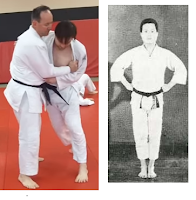About a month ago, kickboxer Gabriel Varga caused a stir when he released his video five stupid things karate teaches you. One of these was the idea of punching with both fists at once, using the mountain punch (yama tsuki in Japanese) as an example.
In taekwondo, this movement only ever appears in pattern Yoo-Sin, where it's called a "U-shaped punch". But it's in multiple karate kata, most notably Bassai Dai.
Varga is correct that it's mechanically weak to punch with both fists at once; you can't apply hip torque the way you can with a single punch. However, most karateka in the bunkai community do not interpret this movement as punching with both fists as once, despite that being the "standard" interpretation.
 |
| (Left) In Karate-Do Kyohan, Ginchin Funakoshi shows the movement applied against a hair grab, an idea General Choi copied in the Encycopedia of Taekwon-Do. (Right) In the Bubishi, a similar hair grab defense is employed, but as a simultaneous throat and groin grab rather than double punch. |
The "double punch" idea has its defenders. Ramsey Dewey pointed out that in sport taekwondo he used it to
set up a kick to the head, and online I've read it works well as a push.
Other interpretations is that it's only one hand that's doing the punching. Iain Abernethy for example interprets it as an overhand punch while the lower fist is pushing down the opponent's arm.
A slight variation of this is Noah Legel's interpretation of an overhand punch while trying to pin the opponent's other hand. Later in the video, he also applies the lower arm as a block.
Alternately, it could be the upper arm that is blocking while you are doing an upset punch to the ribs. This actually looks like an old-time bare-knuckle boxing technique |
| They look similar |
Blocking high while punching low, blocking low while punching high, both make a little more sense than punching with both arms at once.
Grappling Interpretations
The movement has also been interpreted as grabbing the opponent with both fists, which leads into a throw. You could interpret the two U-shaped punches, performed together, as a throw utilizing the footwork as a sweep.
Other throwing interpretations involve more footwork, such as turning, which we do not do in Yoo-Sin.
Following the Angle Punch
Since in Yoo-Sin we perform the first U-shape block after an angle punch, we can combine the two movements into an application. One way to apply the angle punch is as a hammerlock or chicken wing lock, as shown in the image below.
From here, if the opponent resists, grab the back of their shirt. Use the lower arm of the U-shaped punch to pull the opponent's back shirt to your left and down while you execute the high punch to their jaw.
 |
Angle "punch" to U-shape punch application.
|
Hopefully this post has given you some application ideas for the U-shape punch, beyond the "punching with both fists at once" interpretation.

















